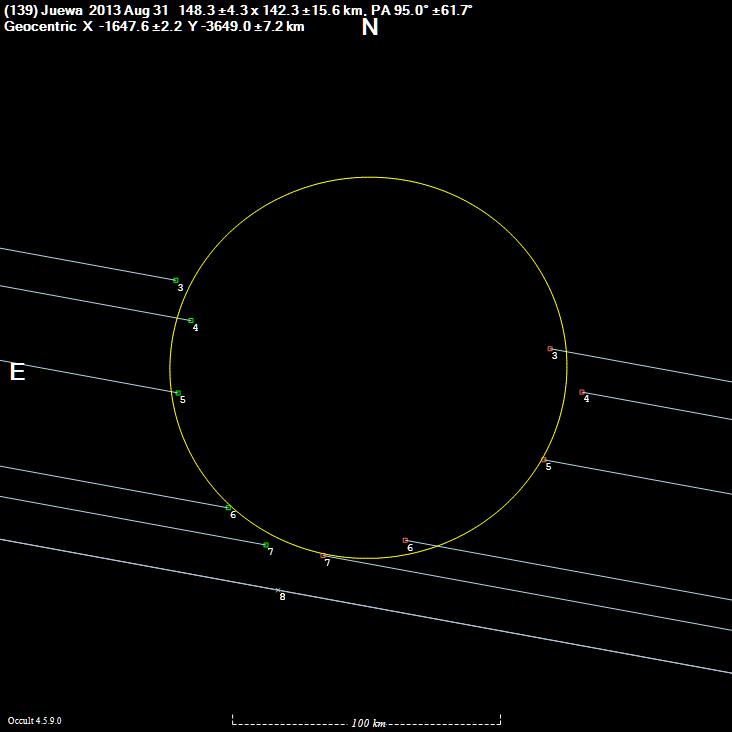139 Juewa on:
[Wikipedia]
[Google]
[Amazon]
139 Juewa is a very large and dark  Since 1988 there have been 8 reported stellar
Since 1988 there have been 8 reported stellar
main belt
The asteroid belt is a torus-shaped region in the Solar System, located roughly between the orbits of the planets Jupiter and Mars. It contains a great many solid, irregularly shaped bodies, of many sizes, but much smaller than planets, called ...
asteroid
An asteroid is a minor planet of the inner Solar System. Sizes and shapes of asteroids vary significantly, ranging from 1-meter rocks to a dwarf planet almost 1000 km in diameter; they are rocky, metallic or icy bodies with no atmosphere.
...
. It is probably composed of primitive carbonaceous
Carbon () is a chemical element with the chemical symbol, symbol C and atomic number 6. It is nonmetallic and tetravalence, tetravalent—its atom making four electrons available to form covalent bond, covalent chemical bonds. It belongs to gro ...
material. It was the first asteroid discovered from China
China, officially the People's Republic of China (PRC), is a country in East Asia. It is the world's most populous country, with a population exceeding 1.4 billion, slightly ahead of India. China spans the equivalent of five time zones and ...
.
Juewa was discovered from Beijing
}
Beijing ( ; ; ), alternatively romanized as Peking ( ), is the capital of the People's Republic of China. It is the center of power and development of the country. Beijing is the world's most populous national capital city, with over 21 ...
by the visiting American astronomer
An astronomer is a scientist in the field of astronomy who focuses their studies on a specific question or field outside the scope of Earth. They observe astronomical objects such as stars, planets, natural satellite, moons, comets and galaxy, g ...
James Craig Watson
James Craig Watson (January 28, 1838 – November 22, 1880) was a Canadian-American astronomer, discoverer of comets and minor planets, director of the University of Michigan's Detroit Observatory in Ann Arbor, and awarded with the Lalande Priz ...
on 10 October 1874; Watson was in China to observe the transit of Venus
frameless, upright=0.5
A transit of Venus across the Sun takes place when the planet Venus passes directly between the Sun and a superior planet, becoming visible against (and hence obscuring a small portion of) the solar disk. During a trans ...
. Watson asked Prince Gong
Yixin (11January 1833– 29May 1898), better known in English as PrinceKung or Gong, was an imperial prince of the Aisin Gioro clan and an important statesman of the Manchu-led Qing dynasty in China. He was a regent of the empire from 1861 to 18 ...
to name the asteroid. Gong's choice was 瑞華星 (roughly, "Star of China’s Fortune"). Watson used only the first two characters, transliterating them as ''Juewa'' according to the conventions of his time (in modern pinyin
Hanyu Pinyin (), often shortened to just pinyin, is the official romanization system for Standard Mandarin Chinese in China, and to some extent, in Singapore and Malaysia. It is often used to teach Mandarin, normally written in Chinese for ...
, it would be transliterated as ''ruìhuá'').
 Since 1988 there have been 8 reported stellar
Since 1988 there have been 8 reported stellar occultation
An occultation is an event that occurs when one object is hidden from the observer by another object that passes between them. The term is often used in astronomy, but can also refer to any situation in which an object in the foreground blocks ...
s by Juewa. From the occultation on 31 August 2013 the best fit ellipse measures 148.3+/-4.3 km x 142.3 +/- 15.6 km.
13-cm radar observations of this asteroid from the Arecibo Observatory
The Arecibo Observatory, also known as the National Astronomy and Ionosphere Center (NAIC) and formerly known as the Arecibo Ionosphere Observatory, is an observatory in Barrio Esperanza, Arecibo, Puerto Rico owned by the US National Science F ...
between 1980 and 1985 were used to produce a diameter estimate of 172 km. Based upon radar data, the near surface solid density of the asteroid is
1.5.
References
External links
* * 000139 Discoveries by James Craig Watson Named minor planets 000139 000139 000139 18741010 {{S-beltasteroid-stub